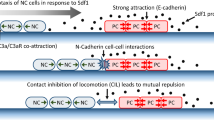Abstract
Although cell migration is an essential process in development, how cells reach their final destination is not well understood. Secreted molecules are known to have a migratory effect, but it remains unclear whether such molecules act as directional guidance cues or as motility regulators. There is potential to use signalling molecules in new medical therapies, so it is important to identify the exact role these molecules play. This paper focuses on distinguishing between inhibitory and repulsive effects produced by signalling molecules, based on recent experiments examining the effect of Slit, a secreted protein, on the migration of neurons from the brain. The primary role of Slit, whether it is an inhibitor or repellent of neurons, is in dispute. We present population-level continuum models and recast these in terms of transition probabilities governing individual cells. Various cell-sensing strategies are considered within this framework. The models are applied to the neuronal migration experiments. To resolve the particular role of Slit, simulations of the models characterising different cell-sensing strategies are compared at the population and individual cell level, providing two complementary perspectives on the system. Difficulties and limitations in deducing cell migration rules from time-lapse imaging are discussed.
Similar content being viewed by others
References
Abercrombie, M., 1980. The crawling movement of cells. Proc. R. Soc. Lond. Ser. B 207, 129–147.
Anderson, A., Chaplain, M.A.J., 1998. Continuous and discrete mathematical models of tumor-induced Bull. angiogenesis. Math. Biol. 60, 857–900.
Alvarez-Buylla, A., 1997. Mechanism of migration of olfactory bulb interneurons. Semin. Cell Dev. Biol. 8, 207–213.
Franz, C.M., Jones, G.E., Ridley, A.J., 2002. Cell migration in development and disease. Dev. Cell 2, 153–158.
Hughes, B.D., 1995. Random Walks and Random Environments, vol. 1. Oxford University Press, Oxford.
Keller, E.F., Segel, L.A., 1971. Travelling bands of chemotactic bacteria: A theoretical analysis. J. Theor. Biol. 30, 235–248.
Landman, K.A., Pettet, G.J., Newgreen, D.F., 2003. Mathematical models of cell colonization of uniformly growing domains. Bull. Math. Biol. 65, 235–262.
Lauffenburger, D.A., Horwitz, A.F., 1996. Cell migration: A physically integrated molecular process. Cell Rev. 84, 359–369.
Lauffenburger, D.A., Linderman, J.J., 1993. Receptors, Models for Binding, Trafficking and Signalling. Oxford University Press, Oxford.
Liggett, T.M., 1985. Interacting Particle Systems. Springer-Verlag, New York.
Mason, H.A., Ito, S., Corfas, G., 2001. Extracellular signals that regulate the tangential migration of olfactory bulb neuronal precursors: Inducers, inhibitors and repellents. J. Neurosci. 21, %(19): 7654–7663.
Menezes, J.R.L., Marins, M., Alves, J.A.J., Fróes, M.M., Hedin-Pereira, C., 2002. Cell migration in the postnatal subventricular zone. %Brazilian Journal of Medical and Biological Research Brazil. J. Med. Biol. Res. 35, 1411–1421.
Montroll, E.W., Weiss, G.H., 1965. Random walks on lattices. II. J. Math. Phys. 6, 167–181.
Murray, J.D., 2002. Mathematical Biology, vol. 1, 3rd edition. Springer-Verlag, New York.
Okubo, A., 1980. Diffusion and Ecological Problems: Mathematical Models. Springer-Verlag, New York.
Othmer, H.G., Stevens, A., 1997. Aggregation, blowup and collapse: The abc's of taxis in reinforced random walks. SIAM J. Appl. Math. 57, 1044–1081.
Painter, K.J., Sherratt, J.A., 2003. Modelling the movement of interacting cell populations.J. Theor. Biol. 225, 327–339.
Simpson, M.J., Landman, K.A., Newgreen, D.F., 2006. Chemotactic and diffusive migration on a non-uniformly growing domain: Numerical algorithm development and applications. J. Compt. Appl. Math. In press. Available online.
Ward, M., McCann, C., DeWulf, M., Wu, J., Rao, Y., 2003. Distinguishing between direction guidance and motility regulation in neuronal migration. J. Neurosci. 23, 5170–5177.
Witt, C., Raychaudhuri, S., Chakraborty, A.K., 2005. Movies, measurement, and modeling: The three Ms of mechanistic immunology. J. Exp. Med. 201, 501–504.
Wolpert, L., 2002. Principles of Development, 2nd edition. %Current Biology, Oxford University Press, Oxford.
Wu, W., Wong, K., Chen, J., Jiang, Z., Dupuis, S., Wu, J., Rao, Y., 1999. Directional guidance of neuronal migration in the olfactory system by the protein Slit. Nature 400, 331–336.
Author information
Authors and Affiliations
Corresponding author
Rights and permissions
About this article
Cite this article
Cai, A.Q., Landman, K.A. & Hughes, B.D. Modelling Directional Guidance and Motility Regulation in Cell Migration. Bltn. Mathcal. Biology 68, 25–52 (2006). https://doi.org/10.1007/s11538-005-9028-x
Received:
Revised:
Published:
Issue Date:
DOI: https://doi.org/10.1007/s11538-005-9028-x




